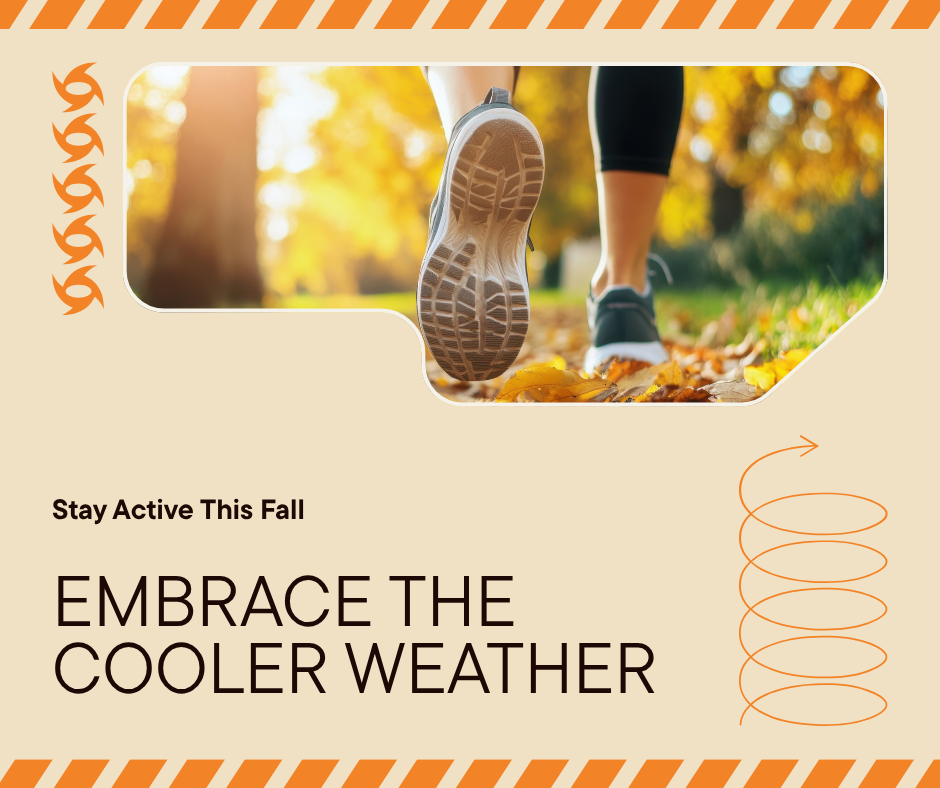
Don't Hibernate! Your Guide to Staying Active Outdoors as Weather Cools
As the vibrant colors of autumn arrive and the temperatures begin to drop, it can be tempting to trade your running shoes for a cozy blanket and settle in for a season of indoor comfort. But don't let the cooler weather stop you! Exercising outdoors in the cooler months offers a host of unique physical and mental benefits that are too good to miss.
Here is your essential guide to embracing the crisp air and staying active and safe outside all season long.
Why Brave the Chill? The Benefits of Cool-Weather Exercise
Getting outside when the weather cools does more than just maintain your fitness routine—it gives you a powerful boost.
-
Elevated Mood and Energy: Cooler temperatures are often less stressful on the body than summer heat, potentially improving your exercise performance. Plus, the fresh air and exposure to natural light can significantly combat feelings of stress, anxiety, and even help fight seasonal affective disorder (SAD), which is common when daylight hours shorten.
-
Burn More Calories: When your body is working to regulate its core temperature in the cold, you naturally use more energy, which can lead to burning more calories during your workout.
-
Immune System Boost: Regular physical activity, even in the cold, is a great way to strengthen your immune system, helping your body fight off those inevitable winter bugs.
-
Get Your Vitamin D: With shorter days, any opportunity to soak up a little natural sunlight is valuable for maintaining your Vitamin D levels.
Gear Up! The Art of Layering
The key to a comfortable and safe cold-weather workout is proper clothing. The goal is to stay warm without overheating and sweating too much, as wet clothing can quickly make you dangerously cold. The solution is layering.
-
The Base Layer (Wick Away): This is the layer next to your skin and is the most important for staying dry. Choose moisture-wicking synthetic materials like polyester or polypropylene—or lightweight wool. Avoid cotton, which absorbs sweat and holds it right against your skin.
-
The Middle Layer (Insulate): This layer traps warmth. Think fleece, wool, or another insulating material. This layer should be removable if you start to heat up.
-
The Outer Layer (Protect): This is your shell against the elements. A lightweight, water-resistant, and windproof jacket is ideal. Look for a material that is also breathable to let excess heat and moisture escape.
Don't Forget the Extremities! You lose a lot of heat through your head, hands, and feet.
-
Wear a hat or headband to cover your ears.
-
Mittens are generally warmer than gloves because your fingers share heat.
-
Wear non-cotton, moisture-wicking socks.
Cool-Weather Activity Ideas
The great outdoors offers endless possibilities when the mercury dips.
-
Hiking or Walking: Enjoy the quiet trails and unique scenery of the season. Choose a trail that is well-marked and be mindful of wet leaves, mud, or icy patches.
-
Running and Biking: The cooler air can make these activities feel less strenuous than in the summer heat. Just remember to add reflective gear if you are out during dawn or dusk.
-
Winter Sports: If you live in a snowy climate, try a new activity like snowshoeing, cross-country skiing, or ice skating.
-
Backyard Fun: Simple activities like raking leaves or a fun, energetic family game of frisbee or obstacle course in the yard count, too!
Safety First: Essential Cool-Weather Tips
Prioritize safety before heading out.
-
Check the Forecast: Be aware of the temperature, wind chill, and any precipitation. If conditions are extremely cold or icy, consider an indoor workout instead.
-
Warm-up and Cool-down: Always start with a dynamic warm-up (like walking in place or stretching) to prepare your muscles.
-
Stay Hydrated: Just because it's cold doesn't mean you don't sweat! Drink water before, during, and after your activity—you can become dehydrated quickly in cold, dry air.
-
Watch Your Footing: Wear shoes with good traction, especially if you anticipate wet or icy surfaces. Consider shoe "grippers" for stability on ice.
-
Tell Someone: Let a friend or family member know where you are going and when you expect to return, and carry a fully charged phone.
-
Protect Your Skin: Yes, you can get sunburned in the winter! Apply sunscreen and wear sunglasses or goggles to protect against sun and snow glare.
Don't let the chilly air be an excuse to press the pause button on your healthy habits. With the right preparation and gear, the crisp, cool air can be the most invigorating backdrop for your best workout yet!
